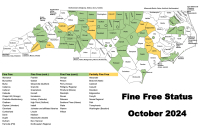EPA takes aim at Canton paper mill
A water pollution permit for the Canton paper mill has come under fire by the Environmental Protection Agency.
The pollution permit is up for a periodic review by the state. The EPA isn’t pleased with the standards the state has proposed and is calling for tougher limits.
If the state doesn’t ratchet up the controls, the EPA has threatened to step in and handle the permit itself. The EPA gave the state 90 days to respond with a rewritten permit. Such intervention is rare.
The state environmental engineer who wrote the draft permit was barred from speaking to the press after making controversial comments to other newspapers last week. Sergei Chernikov told media outlets that the standards suggested by EPA would come with astronomical costs that are financially out of reach for Evergreen Packaging. He also defended the mill and spoke out against the tougher requirements being sought by EPA. After the comments appeared in print, the Division of Water Quality press office took over media inquiries related to the EPA intervention.
“The information Sergei expressed was the information he had when he designed the draft permits. But we have other information being evaluated,” said Susan Massengale, public information officer for the Division of Water Quality. “It is a much bigger picture.”
Three hearing officers will ultimately decide on how stringent the state permit is, not the engineer who wrote the draft permit. The suggested limits in the draft permit are only part of what the hearing officers will consider when making a final decision, Massengale said.
Related Items
They will take into account numerous comments from the public input period, from environmental groups to mill supporters. The EPA falls in that category as well, Massengale said.
“It has submitted its comments for this process the same as any other commenter,” Massengale said.
But unlike the other commenters, the EPA carries regulatory weight and can mandate pollution limits by taking over the permit.
Massengale would not comment on what limits the EPA wants tightened up.
“I am not going to parse the language. That is up to the hearing officers,” Massengale said.
To Hope Taylor, executive director of Clean Water for NC, the EPA recommendations don’t go far enough.
“If you were going to bother objecting to the permit, why not do so in a way that could accomplish a lot more?” Taylor said
For example, the color limit recommended by the EPA of 36,000 pounds a day is only 1,000 pounds less than what the mill is discharging now. And while the EPA is taking a tougher stance on temperature, it would only look at monthly averages, which does nothing to rein in spikes of hot discharges that can lead to fish kills, Taylor said.
During the 1990s, the mill embarked on a $330 million environmental overhaul, spurred partly by expensive lawsuits. Environmentalists and downstream communities want the mill to make further improvements. But instead, it seems progress has plateaued.
As for Evergreen Packaging, they released a written statement about the news saying that the EPA comments were part of the permit process, which is designed to consider all voices and viewpoints.
“We look forward to continuing to work with regulators on finalizing a permit to continue the progress that has been made,” the statement read.
What the EPA wants
Evergreen paper mill in Canton sucks roughly 29 million gallons a day out of the river and uses it in myriad aspects of the paper making process — from cooling coal-fired boilers to flushing chemicals through wood pulp — and then dumps it back in the river again.
The EPA wants the mill to reduce the dark color of its discharges slightly beyond what the state is calling for and wants to see a study of color going into the Pigeon River. The state was willing to reclassify the mill as being in compliance with the state’s color standards and no longer in need of a color pollution variance, but the EPA maintains that the mill should not come out from under the oversight of a color variance.
The water the mill puts back in the river is much hotter than the river’s natural temperature. The EPA also wants tougher limits on the temperature than the state asked for.
The state also was willing to drop testing of fish tissue for dioxins, since there is no longer a warning against eating any of the fish species from the Pigeon. But the EPA still wants to see testing every other year. The state proposed monitoring dioxin discharges based on a monthly average, but the EPA wants a maximum daily limit imposed as well. The EPA also called for more monitoring in several areas the state was willing to overlook.









